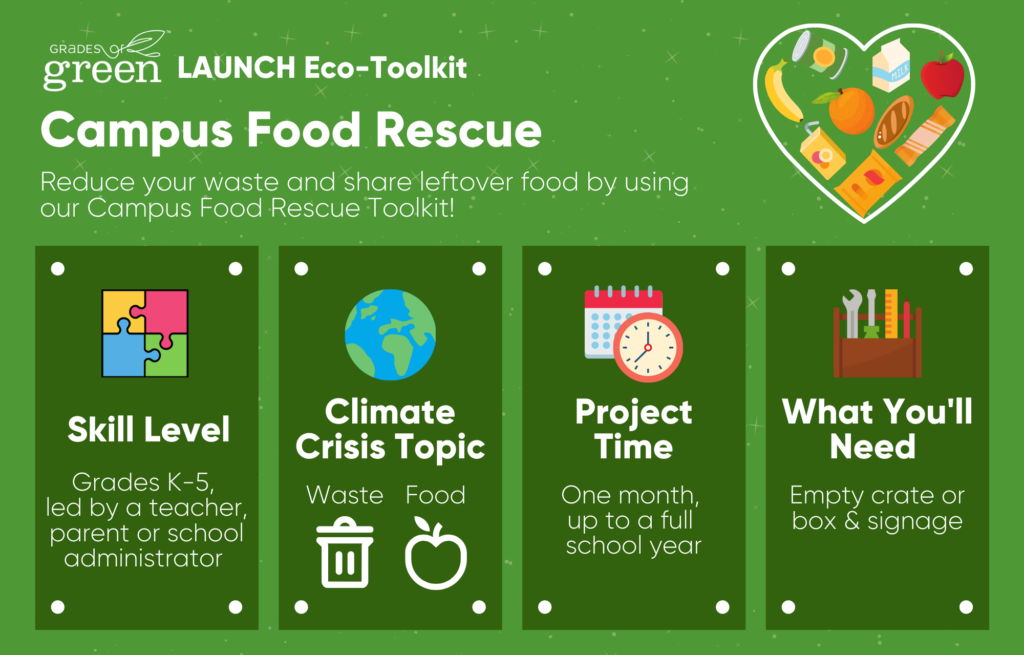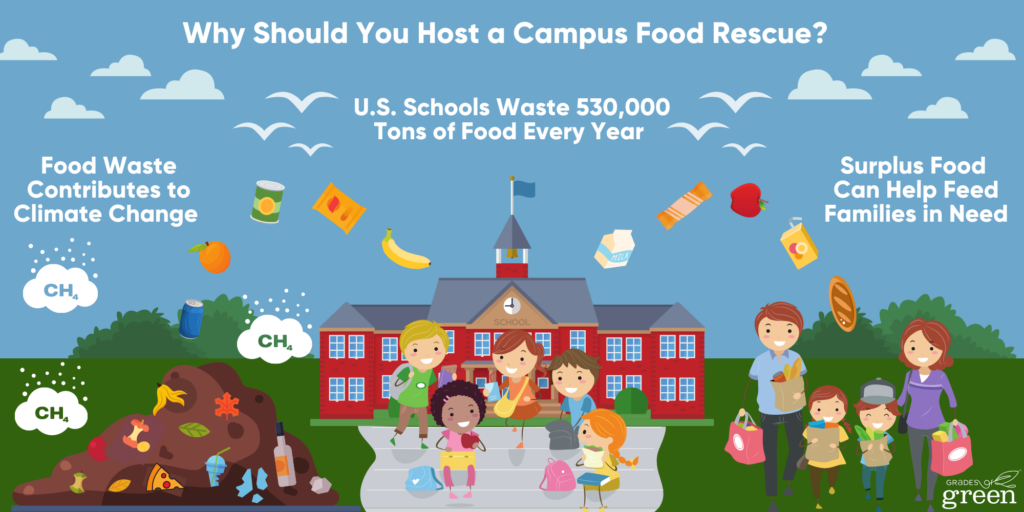Rescue Food From the Big Bad Trash Monster!
It’s time to stop sending wonderful, edible food to the landfill. Reduce your waste and share leftover food with this Campus Food Rescue Toolkit.

Toolkit Details


NGSS
This toolkit address the following Science and Engineering Practices (SEPs) within the Performance Expectations of NGSS for Grades: K-2 and 3-5
- Asking Questions and Defining a Problem
- Planning and Carrying out Investigations
- Analyzing and Interpreting Data
- Using Mathematics and Computational Thinking
- Constructing Explanations and Designing Solutions
- Obtaining Evaluating, and Communicating Information
Learning Objectives
- Project Management
- Students will identify routines to accomplish their goal of rescuing edible food
- Students will practice leadership skills by delegating tasks to one another as needed
- Collaboration
- Evaluation and Assessment
- Students will track and evaluate the impact of their project.
What You Will Accomplish
A campus food rescue program will cut down the amount of edible food that ends up going to a landfill, which will reduce methane emissions that lead to climate change. At the same time, this food can be reused to feed students on campus or community members who struggle with food insecurity.
- The USDA supports the use of food donations and share tables and offers implementation guidance.
- To encourage institutions to donate healthy food that would otherwise go to waste, protection from criminal and civil liability is provided under the Good Samaritan Food Donation Act.
Educator Project Plan
Follow the steps below to set up a successful Campus Food Rescue at your school! Need help? Contact us!
Track your metrics and submit your impact after implementing this toolkit. Your feedback helps keep our programs free for all across the globe.
Determine Participants
Use our Campus Food Rescue Sign-Up Sheet Template
- A Student Group such as (a club, before/after school program, non-school organization)
- A whole class
- The whole school
- Working with a small group of students? Pick one or two days per week to hold your food rescue and consider setting up a share box that will be available to hungry students on campus.
- Working with a larger team? Add a food rescue system into your lunchtime routine every day and partner with an organization that will collect and deliver the food to community members in need.
Why Should You Host a Campus Food Rescue
The resources provided below can be shown as a slideshow or printed out as individual worksheets for students to review.

Food Waste Is Expensive
A lot of perfectly good food is wasted across the world every day for many different reasons. On school campuses, food waste usually happens because students don’t like the food that is served, are given more food than they can eat, or don’t have enough time to eat their entire meal. The result is a lot of food being thrown in the trash, which ends up in landfills. Reports estimate that U.S. schools waste 530,000 tons of food per year, which costs as much as $9.7 million a day to manage. [1]
Food Waste Heats Up the Earth
Food waste in landfills is a big contributor to climate change. When food breaks down in a landfill, it gives off methane, a powerful greenhouse gas. According to the Environmental Protection Agency, food is the single largest category of material placed in United States’ landfills and is the third-largest source of human-related methane emissions in the country. [2]
Food Can Be Repurposed
Safe and wholesome food that is currently being wasted could help feed families and individuals in need and reduce food insecurity. Each year, food banks like Feeding America rescue and redistribute around 3.6 billion pounds of food – only a small percentage of the food that could have been donated instead of going to a landfill. [2]
Why Food Waste is a Social Justice Issue
Everyone on Earth needs to eat fruits, vegetables, and proteins, but our food comes from really big animal factories and agricultural farms that cause a lot of pollution to the communities close by. These facilities are usually created in areas where the land is cheaper and where less wealthy individuals or Black, Brown, and Indigenous communities live nearby. Food and food waste is an Environmental Justice issue because these community members start to experience health issues and experience other environmental injustices like polluted water from those facilities. We can help manage our food waste and limit how much new food the world needs if we collect and share uneaten and healthy food to those in need.
Watch this Short Video to Learn More on Reducing Food Waste at School
Think About It!
Pre-Activity Questions
- What types of food do you see thrown away the most at school?
- Why do you think food waste is harmful to the planet?
- Can you think of places in your community that need more fresh and healthy food?
Take Action: How to LAUNCH Food Rescue
Lead students through the “Campus Food Rescue” activity with guided instructions. Check out “Pro Tips” for additional help.
1. Assign Roles
- Determine who and how many students/staff are participating. Use the Campus Food Rescue Sign Up Sheet
- Assign participants to roles such as:
- Peer education and marketing
- Overseeing food collection at lunch
- Communicating and developing a plan with a partner organization
2. Meet Your School’s Decision Makers
Set up a meeting with your principal and custodial staff to get permission and discuss the best way to add a food rescue program into your current lunchtime routine.
3. Connect With a Partner
- Find and connect with a partner organization that will either accept or redistribute your rescued food throughout the community like a foodbank, church, shelter or food rescue organization. Some organizations have the ability to come and collect food at your campus while others will ask that food be delivered to them. If food needs to be delivered, find a parent or staff volunteers who can help manage this.
- Work with the partner organization to decide how often food will be picked up in addition to the logistics of collecting food from campus (where it will be stored, how they will gain access to campus, etc.).
- Some partner organizations that we suggest reaching out to are:
- Careit App – connects you with food banks in your area throughout the US and Canada
- Food Finders (Limited to Southern California)
- Or, you can keep rescued food on campus by using a “share basket” so that the food can be given to other students who are still hungry or can be offered in after-school programs.
4. Pre-Food Rescue Observation
Before you begin your Campus Food Rescue program, have student volunteers see how much edible food is wasted at the end of a lunch period. Estimate how much thrown out food could have been donated using this audit sheet.
5. Plan It Out
- Pick a date to kick off your Campus Food Rescue program
- Decide what foods you will be collecting and where it will be stored
- Non-perishable, unopened packaged foods and whole fruits can be stored in a secure location on campus until it is collected for redistribution.
- Perishable foods such as milk, juice and hot foods will need to be stored in a refrigerator or warming area on campus until it is redistributed. According to California health standards, cold food should be stored at 41ºF or below while hot foods should be stored at 140º or above prior to donation release.
- Create a schedule for your team to:
- Monitor the food collection at lunch to make sure that only the predetermined foods are placed in the food collection container
- Collect rescued foods each day from the lunch area after all students have eaten and take it to where it will be stored on campus
- Use the Campus Food Rescue Organizer resource to keep track of your schedule
6. Educate Your Classmates and School Staff
Use this script to educate your community how and why rescuing edible food is good for the planet and community.
7. Set up Your Food Rescue Station in the Lunch Area
- Work with your custodial and lunch staff to determine the best method of collecting edible foods during lunch
- Find a table and container for students to place their uneaten foods
- Get Creative! Make and print signs (or use this Food Donation Sign or Share Basket Sign) to let students know which foods can be sorted for rescue.
- Repurpose tables or desks from your campus along with items like plastic milk crates for collecting food.
8. Kick Off Your Food Rescue Program
- On your predetermined date, make sure the entire school community knows that your campus food rescue program is starting. Use announcements or a school newsletter to spread the word. Customize this template for your announcements.
- Have student volunteers in the lunch area remind students which items can be sorted into food rescue and make sure that only those items are placed in the containers.
- Using the Campus Food Rescue Audit, keep track of how much and what type of food is being collected. These totals can be used for the Campus Food Rescue Organizer and should be compared with the Pre-Project Audit to measure your impact.
- After all students have eaten, scheduled student volunteers should record donated food on the Campus Food Rescue Organizer and take it to a safe area on campus to be stored until it is redistributed to your partner organization.
Reflection Questions
How’d It Go?
- What foods are donated to the food rescue most often?
- Explain how you and your classmates have become more aware about food waste since doing this project?
- What have you enjoyed the most about doing this project?
Report Students’ Impact
Congratulations!! You’ve implemented Campus Food Rescue! Don’t let all that hard work go unnoticed. Submit your results by clicking the green button below.
Project ongoing? No problem! Let us know what you’ve done so far.
By reporting your impact, Grades of Green can:
- CELEBRATE and elevate your students’ hard work and success.
- Offer our programs FREE for all students across the globe.
- AWARD stipends and certificates to hard-working educators and students.
Please take a few minutes to submit your results. Thank you!
Provided Resources
- Campus Food Rescue Sign-up sheet
- Campus Food Rescue Organizer
- Campus Food Rescue Peer Education Script
- Campus Food Rescue Pre-Project Audit
- Campus Food Rescue Audit
- Campus Food Rescue Wrap Form
- Share Basket Signs
- Food Donation Signs
- Food Rescue Newsletter/Announcement
- Toolkit Resources – Google Drive Folder
Congrats on completing Campus Food Rescue Program Eco-Toolkit!
Did you enjoy this toolkit? Find your next project here!